rear view mirror MITSUBISHI OUTLANDER 2020 (in English) Owner's Guide
[x] Cancel search | Manufacturer: MITSUBISHI, Model Year: 2020, Model line: OUTLANDER, Model: MITSUBISHI OUTLANDER 2020Pages: 443, PDF Size: 60.03 MB
Page 236 of 443
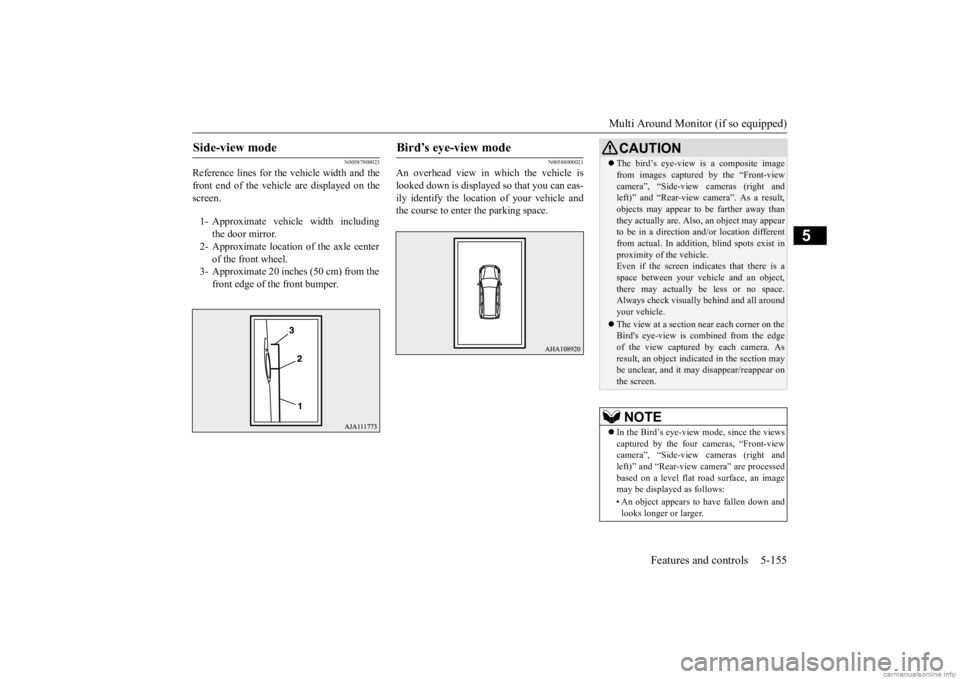
Multi Around Monitor (if so equipped)
Features and controls 5-155
5
N00587900023
Reference lines for the
vehicle width and the
front end of the vehicle are displayed on the screen.
N00588000021
An overhead view in which the vehicle is looked down is displaye
d so that you can eas-
ily identify the location of your vehicle andthe course to enter the parking space.
Side-view mode
1- Approximate vehi
cle width including
the door mirror.
2- Approximate location of the axle center
of the front wheel.
3- Approximate 20 inches (50 cm) from the
front edge of the front bumper.
Bird’s eye-view mode
CAUTION The bird’s eye-view is a composite image from images captured by the “Front-viewcamera”, “Side-view cameras (right andleft)” and “Rear-view camera”. As a result, objects may appear to
be farther away than
they actually are. Also, an object may appearto be in a direction a
nd/or location different
from actual. In addition, blind spots exist in proximity of the vehicle.Even if the screen indicates that there is a space between your ve
hicle and an object,
there may actually be less or no space.Always check visually
behind and all around
your vehicle. The view at a section near each corner on the Bird's eye-view is combined from the edge of the view captured by each camera. Asresult, an object indica
ted in the section may
be unclear, and it may
disappear/reappear on
the screen.NOTE
In the Bird’s eye-view mode, since the views captured by the four cameras, “Front-viewcamera”, “Side-view cameras (right and left)” and “Rear-view camera” are processed based on a level flat road surface, an imagemay be displayed as follows: • An object appears to
have fallen down and
looks longer or larger.
BK0278200US.book 155 ページ 2019年4月10日 水曜日 午前10時59分
Page 297 of 443
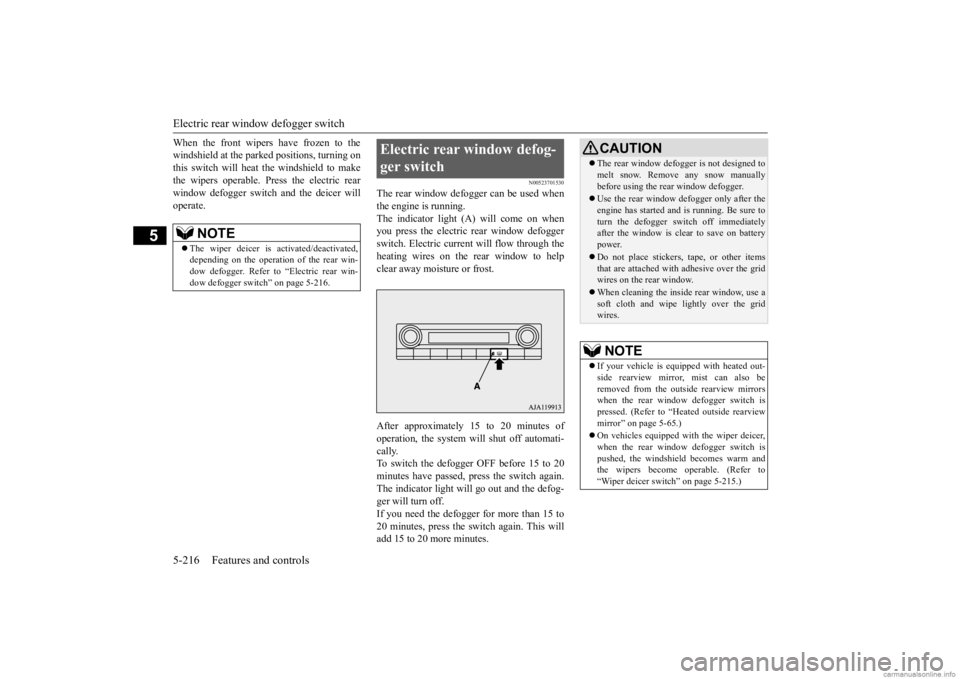
Electric rear window defogger switch 5-216 Features and controls
5
When the front wipers have frozen to the windshield at the parked
positions, turning on
this switch will heat the windshield to make the wipers operable. Press the electric rear window defogger switch and the deicer willoperate.
N00523701530
The rear window defogger can be used when the engine is running. The indicator light (A) will come on whenyou press the electric rear window defogger switch. Electric current will flow through the heating wires on the rear window to helpclear away moisture or frost. After approximately 15 to 20 minutes of operation, the system will shut off automati- cally. To switch the defogger OFF before 15 to 20minutes have passed, pr
ess the switch again.
The indicator light will go out and the defog- ger will turn off.If you need the defogger for more than 15 to 20 minutes, press the switch again. This will add 15 to 20 more minutes.
NOTE
The wiper deicer is
activated/de
activated,
depending on the operation of the rear win-dow defogger. Refer to
“Electric rear win-
dow defogger switch” on page 5-216.
Electric rear window defog- ger switch
CAUTION The rear window defogge
r is not designed to
melt snow. Remove any snow manuallybefore using the rear window defogger. Use the rear window defogger only after the engine has started and
is running. Be sure to
turn the defogger switch off immediately after the window is clea
r to save on battery
power. Do not place stickers
, tape, or other items
that are attached with
adhesive over the grid
wires on the rear window. When cleaning the insi
de rear window, use a
soft cloth and wipe
lightly over the grid
wires.NOTE
If your vehicle is equi
pped with heated out-
side rearview mirror
, mist can also be
removed from the outsi
de rearview mirrors
when the rear window
defogger switch is
pressed. (Refer to “H
eated outside rearview
mirror” on page 5-65.) On vehicles equipped wi
th the wiper deicer,
when the rear window
defogger switch is
pushed, the windshiel
d becomes warm and
the wipers become operable. (Refer to “Wiper deicer switc
h” on page 5-215.)
BK0278200US.book 216 ページ 2019年4月10日 水曜日 午前10時59分
Page 298 of 443
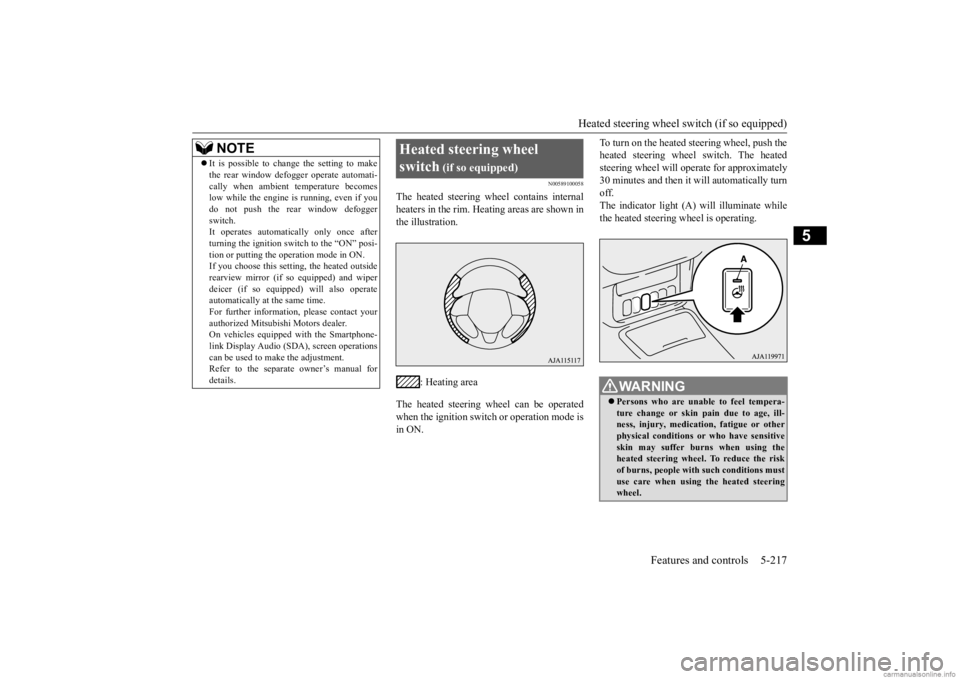
Heated steering wheel switch (if so equipped)
Features and controls 5-217
5
N00589100058
The heated steering wheel contains internal heaters in the rim. Heating areas are shown in the illustration.
: Heating area
The heated steering wheel can be operated when the ignition switch or operation mode is in ON.
To turn on the heated steering wheel, push the heated steering wheel switch. The heatedsteering wheel will ope
rate for approximately
30 minutes and then it
will automatically turn
off.The indicator light (A) will illuminate while the heated steering wheel is operating.
It is possible to cha
nge the setting to make
the rear window defogger operate automati-cally when ambient temperature becomeslow while the engine is running, even if you do not push the rear window defogger switch.It operates automati
cally only once after
turning the ignition sw
itch to the “ON” posi-
tion or putting the ope
ration mode in ON.
If you choose this setting, the heated outside rearview mirror (if so
equipped) and wiper
deicer (if so equippe
d) will also operate
automatically at the same time. For further informati
on, please contact your
authorized Mitsubish
i Motors dealer.
On vehicles equipped with the Smartphone- link Display Audio (SDA), screen operations can be used to make the adjustment.Refer to the separate owner’s manual for details.NOTE
Heated steering wheel switch
(if so equipped)
WA R N I N G Persons who are unable to feel tempera- ture change or skin
pain due to age, ill-
ness, injury, medicati
on, fatigue or other
physical conditions or who have sensitive skin may suffer burns when using theheated steering wheel. To reduce the risk of burns, people with such conditions must use care when using the heated steeringwheel.
BK0278200US.book 217 ページ 2019年4月10日 水曜日 午前10時59分
Page 403 of 443
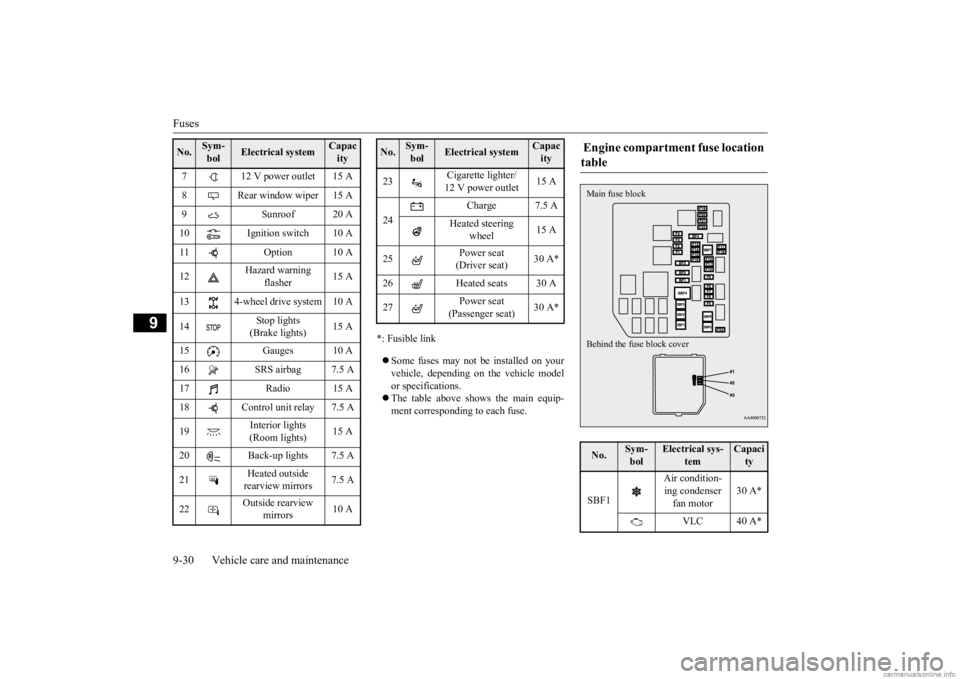
Fuses 9-30 Vehicle care and maintenance
9
*: Fusible link Some fuses may not be installed on your vehicle, depending on
the vehicle model
or specifications. The table above show
s the main equip-
ment corresponding to each fuse.
7 12 V power outlet 15 A 8 Rear window wiper 15 A 9 Sunroof 20 A 10 Ignition switch 10 A11 Option 10 A 12
Hazard warning
flasher
15 A
13 4-wheel drive system 10 A 14
Stop lights (Brake lights)
15 A
15 Gauges 10 A 16 SRS airbag 7.5 A 17 Radio 15 A18 Control unit relay 7.5 A 19
Interior lights (Room lights)
15 A
20 Back-up lights 7.5 A 21
Heated outside rearview mirrors
7.5 A
22
Outside rearview
mirrors
10 A
No.
Sym- bol
Electrical system
Capacity
23
Cigarette lighter/ 12 V power outlet
15 A
24
Charge 7.5 A
Heated steering
wheel
15 A
25
Power seat (Driver seat)
30 A*
26 Heated seats 30 A 27
Power seat (Passenger seat)
30 A*
No.
Sym- bol
Electrical system
Capacity
Engine compartment fuse location table No.
Sym- bol
Electrical sys-
tem
Capacity
SBF1
Air condition- ing condenser fan motor
30 A*
VLC 40 A*
Behind the fuse block cover Main fuse block
BK0278200US.book 30 ページ 2019年4月10日 水曜日 午前10時59分
Page 417 of 443

Cleaning the outside of your vehicle 9-44 Vehicle care and maintenance
9
N00945901738
Chemicals cont
ained in the dirt and dust
picked up from air, rain, snow, or road sur- faces can damage the paint and body of yourvehicle if left on. Frequent washing and wa
xing is the best way
to protect your vehicl
e from this damage.
Do not wash the vehicle in direct sunlight. Park the vehicle in the shade and spray it with water to remove dust.
Next, using plenty of
clean water and
a car washing mitt or sponge,
wash the vehicle from top to bottom.Use a mild car washing soap if necessary. Rinse thoroughly and wipe dry with a cham- ois or soft cloth. After washing the vehicle,carefully clean the joints and flanges of the doors, hood, etc., wher
e dirt is likely to
remain.
Salt and other chemical
s used on winter roads
in some geographical ar
eas can have a detri-
mental effect on the vehicle underbody. You should flush the underbody with a high pres- sure hose every time you wash the outside ofyour vehicle. Take special care to
remove mud or other
debris which could trap and hold salt andmoisture. After washing your vehicle, wipe off all waterdrops from the rubber parts around thedoors to prevent the doors from freezing.
Wa s h i n g
CAUTION When washing the underside of your vehicle or the wheels, wear a pair of gloves to pro- tect your hands. If your vehicle is equippe
d with the rain sen-
sor, place the wiper switch lever in the“OFF” position to deacti
vate the rain sensor
before washing the vehi
cle. Otherwise, the
wipers will operate in
the presence of water
spray on the windshield and may get dam- aged as a result.
Never spray or splash
water on the electrical
parts in the engine compartment. This maydamage them. Be careful also when washingthe underbody to ensure that water does not enter the engine compartment. Avoid automatic car washers that use rotat- ing brushes. These brushes may scratch the paint surface and make it dull.Scratches are more not
iceable on darker col-
ored vehicles. Some hot water wash
ing equipment uses
high pressure and heat to clean your vehicle. Because hot water can da
mage plastics parts
and seep inside your ve
hicle, make sure you
do the following when using such equip- ment:• Keep the washing nozzle at least 28 inches(70 cm) away from the vehicle body.• When washing around the door glass, holdthe nozzle at a distance of more than 28inches (70 cm) and at a right angle to the glass surface.
Make sure to do the following when using an automatic car wash, with help from either this manual or the car wash operator, toavoid damaging your vehicle:• Fold the outside rearview mirrors.• Tape or remove the rear wiper arm assem-bly.• If your vehicle is equipped with roof railsor a roof spoiler, check with the car washoperator before using the car wash.CAUTION
• If your vehicle is equipped with the rainsensor, place the wiper switch lever in the“OFF” position to deac
tivate the rain sen-
sor.
During cold weather
NOTE
When the door is frozen, opening it by force may tear off or crack the rubber gasketinstalled around the door. Pour warm water to melt the ice. Be sure to thoroughly wipe off the water after opening the door. To pre-vent freezing of the we
atherstripping on the
doors, hood, etc., treat with silicone lubri- cant.CAUTION
BK0278200US.book 44 ページ 2019年4月10日 水曜日 午前10時59分
Page 436 of 443
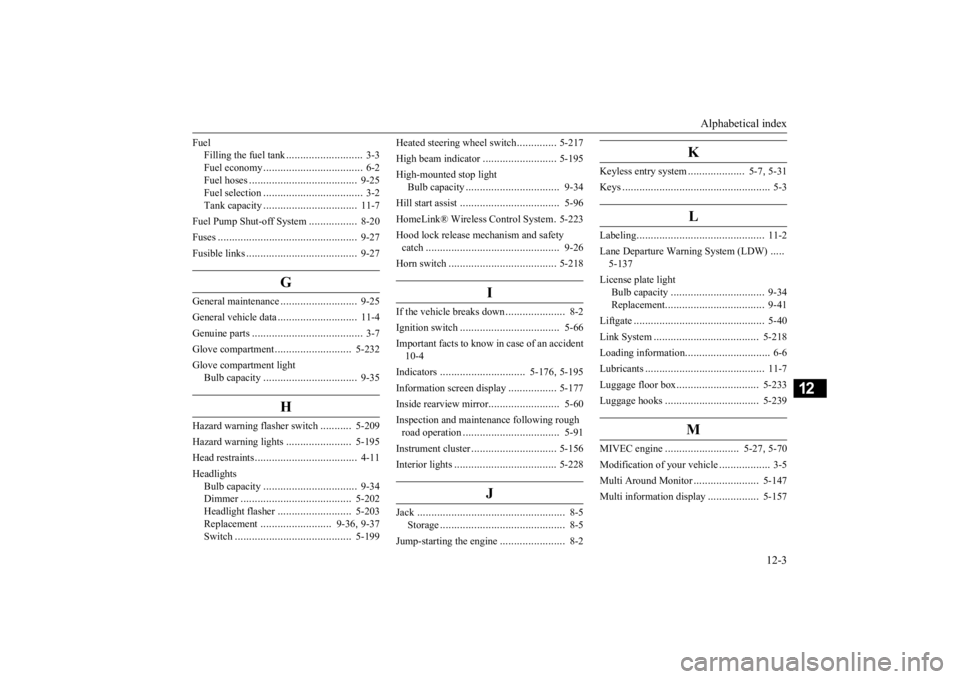
Alphabetical index
12-3
12
Fuel
Filling the fuel tank
...........................
3-3
Fuel economy
...................................
6-2
Fuel hoses
......................................
9-25
Fuel selection
...................................
3-2
Tank capacity
.................................
11-7
Fuel Pump Shut-off System
.................
8-20
Fuses
.................................................
9-27
Fusible links
.......................................
9-27
G
General maintenance
...........................
9-25
General vehicle data
............................
11-4
Genuine parts
.......................................
3-7
Glove compartment
...........................
5-232
Glove compartment light
Bulb capacity
.................................
9-35
H
Hazard warning
flasher switch
...........
5-209
Hazard warning lights
.......................
5-195
Head restraints
....................................
4-11
Headlights
Bulb capacity
.................................
9-34
Dimmer
.......................................
5-202
Headlight flasher
..........................
5-203
Replacement
.........................
9-36
, 9-37
Switch
.........................................
5-199
Heated steering wheel switch
..............
5-217
High beam indicator
..........................
5-195
High-mounted stop light
Bulb capacity
.................................
9-34
Hill start assist
...................................
5-96
HomeLink® Wireless
Control System
.5-223
Hood lock release me
chanism and safety
catch
...............................................
9-26
Horn switch
......................................
5-218
I
If the vehicle breaks down
.....................
8-2
Ignition switch
...................................
5-66
Important facts to know in
case of an accident
10-4 Indicators
..............................
5-176
, 5-195
Information screen display
.................
5-177
Inside rearview mirror
.........................
5-60
Inspection and maintena
nce following rough
road operation
..................................
5-91
Instrument cluster
..............................
5-156
Interior lights
....................................
5-228
J
Jack
....................................................
8-5
Storage
............................................
8-5
Jump-starting the engine
.......................
8-2
K
Keyless entry system
....................
5-7
, 5-31
Keys
....................................................
5-3
L
Labeling
.............................................
11-2
Lane Departure Warning System (LDW)
.....
5-137 License plate light
Bulb capacity
.................................
9-34
Replacement
...................................
9-41
Liftgate
..............................................
5-40
Link System
.....................................
5-218
Loading information
..............................
6-6
Lubricants
..........................................
11-7
Luggage floor box
.............................
5-233
Luggage hooks
.................................
5-239
M
MIVEC engine
..........................
5-27
, 5-70
Modification of your vehicle
..................
3-5
Multi Around Monitor
.......................
5-147
Multi information display
..................
5-157
BK0278200US.book 3 ページ 2019年4月10日 水曜日 午前10時59分
Page 437 of 443

Alphabetical index 12-4
12
O
Octane number
.....................................
3-2
Oil
Engine oil
......................................
11-7
Rear axle oil
...................................
11-7
Transfer oil
....................................
11-7
Operation under adverse driving conditions
...
8-19 Outside rearview mirrors
.....................
5-63
Overheating
.........................................
8-4
P
Parking
................................................
6-6
Parking brake
.................................
5-56
Parking brake lever stroke
...................
9-23
Parking lights
Bulb capacity
.................................
9-34
Replacement
..................................
9-38
Polishing
............................................
9-45
Power brakes
......................................
5-93
Power liftgate
.....................................
5-42
Power outlet
.....................................
5-221
Power windows
..................................
5-51
Puncture (Tire changing)
.....................
8-11
Puncture (Tire repair kit)
.......................
8-6
R
Radiator cap
.......................................
9-10
Radio
General information
about your radio 7-14
Reading lights
Bulb capacity
..................................
9-35
Rear axle oil
..............................
9-13
, 11-7
Rear combination lights
Bulb capacity
..................................
9-34
Replacement
...................................
9-40
Rear Cross Traffic Alert
.....................
5-133
Rear side-marker lights
Bulb capacity
..................................
9-34
Rear turn signal light
Bulb capacity
..................................
9-34
Replacement
...................................
9-40
Rear-view camera
.............................
5-145
Rearview mirror
Inside rearview mirror
.....................
5-60
Outside rearview mirrors
.................
5-63
Replacement of light bulbs
...................
9-33
Replacing tires and wheels
...................
9-21
Reporting Safety Defects
.....................
10-2
S
Safe driving techniques
.........................
6-4
S-AWC (Super-All Wheel Control)
......
5-85
Seat belt
.............................................
4-18
Adjustable seat belt shoulder anchor
.4-24
Child restraint systems
....................
4-27
Front passenger seat belt warning light
.....
4-24Maintenance and inspection
.............
4-35
Seat belt extender
...........................
4-25
Seat belt force limitter
.....................
4-27
Seat belt pr
e-tensioners
...................
4-26
Seat belt use
during pregnancy
.........
4-26
Seats
....................................................
4-2
Arm rest
........................................
4-10
Front seats
.......................................
4-4
Head restraints
...............................
4-11
Heated seat
......................................
4-8
Making a cargo area
........................
4-13
Making a flat seat
...........................
4-17
Seat arrangement
..............................
4-3
Seats and restraint systems
................
4-4
Second row seats
..............................
4-9
Third row seats
...............................
4-11
Service brake
......................................
5-92
Service precautions
...............................
9-2
Side turn-signal light
Bulb capacity
.................................
9-34
Snow tires
..........................................
9-22
Spark plugs
........................................
9-24
Starting the engine
.....................
5-26
, 5-68
Steering
Steering wheel height and reach adjustment
BK0278200US.book 4 ページ 2019年4月10日 水曜日 午前10時59分